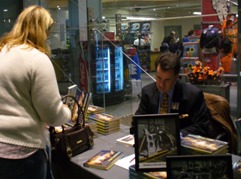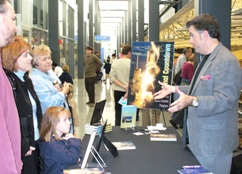|

Pat Duggins
Senior News Analyst
pduggins@wmfe.org
November 19, 2007—To quote our friends at Disney World, it IS a small world after all. I set up shop over the weekend for eight hours worth of book signings at the Smithsonian Institution in Washington, D.C., and among the hundreds who stopped by to talk or get a book signed was Doug and Denise of Orlando. There were also NPR listeners from North Carolina and New Hampshire, among others, who made their presence known.
 I have to admit, during the event, it was easy to feel upstaged by the pieces of aerospace history at the National Air and Space Museum on the Mall. I didn’t get a chance to browse around, but from the desk where they had me stationed at the museum bookshop, I could see the Apollo 11 Command Module Capsule "Columbia", the X-15 rocket plane used by notables including Neil Armstrong, and Lindberg’s "Spirit of St. Louis". Those were the exhibits within eyeshot. When I arrived that morning, I strolled past John Glenn's "Friendship Seven" Mercury Capsule, and the "American Eagle" Gemini Capsule where astronaut Ed White did the first U.S. Spacewalk. Above me, at my desk, was the model of the Hindenberg used in the movie by George C. Scott. I have to admit, during the event, it was easy to feel upstaged by the pieces of aerospace history at the National Air and Space Museum on the Mall. I didn’t get a chance to browse around, but from the desk where they had me stationed at the museum bookshop, I could see the Apollo 11 Command Module Capsule "Columbia", the X-15 rocket plane used by notables including Neil Armstrong, and Lindberg’s "Spirit of St. Louis". Those were the exhibits within eyeshot. When I arrived that morning, I strolled past John Glenn's "Friendship Seven" Mercury Capsule, and the "American Eagle" Gemini Capsule where astronaut Ed White did the first U.S. Spacewalk. Above me, at my desk, was the model of the Hindenberg used in the movie by George C. Scott.
 The day after that, I spent the afternoon at the Smithsonian’s newest Air and Space Museum, the Udvar-Hazy Center out by Dulles. NASA history was ever present there as well, with the Space Shuttle Enterprise that made the approach and landing tests in the 1970’s that proved the shuttle could glide to a safe landing. It also played a pivotal role in the investigation into the Columbia accident. NASA fired pieces of foam at the leading edge of Enterprise’s left wing to see if the debris could damage the heat shields. They left the scuffs on the wings as they were. The day after that, I spent the afternoon at the Smithsonian’s newest Air and Space Museum, the Udvar-Hazy Center out by Dulles. NASA history was ever present there as well, with the Space Shuttle Enterprise that made the approach and landing tests in the 1970’s that proved the shuttle could glide to a safe landing. It also played a pivotal role in the investigation into the Columbia accident. NASA fired pieces of foam at the leading edge of Enterprise’s left wing to see if the debris could damage the heat shields. They left the scuffs on the wings as they were.
On a completely separate note, the astronauts set to fly Space Shuttle Atlantis next month are in town for launch pad training. They’re scheduled to carry up the new Columbus lab to the international space station.
More to come.
|
|
|